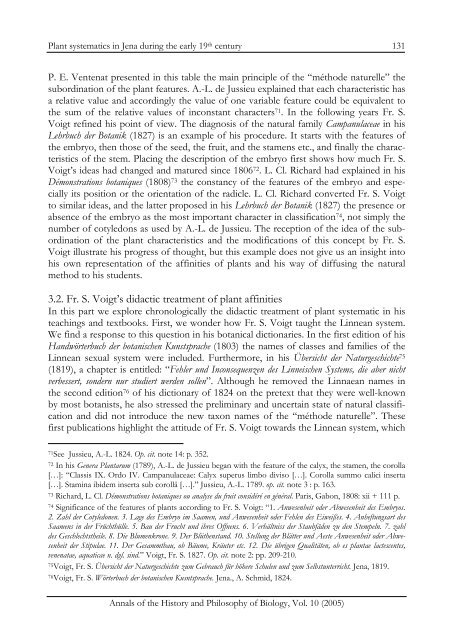Annals of the History and Philosophy of Biology
Annals of the History and Philosophy of Biology
Annals of the History and Philosophy of Biology
Create successful ePaper yourself
Turn your PDF publications into a flip-book with our unique Google optimized e-Paper software.
Plant systematics in Jena during <strong>the</strong> early 19 th century<br />
P. E. Ventenat presented in this table <strong>the</strong> main principle <strong>of</strong> <strong>the</strong> “méthode naturelle” <strong>the</strong><br />
subordination <strong>of</strong> <strong>the</strong> plant features. A.-L. de Jussieu explained that each characteristic has<br />
a relative value <strong>and</strong> accordingly <strong>the</strong> value <strong>of</strong> one variable feature could be equivalent to<br />
<strong>the</strong> sum <strong>of</strong> <strong>the</strong> relative values <strong>of</strong> inconstant characters 71. In <strong>the</strong> following years Fr. S.<br />
Voigt refined his point <strong>of</strong> view. The diagnosis <strong>of</strong> <strong>the</strong> natural family Campanulaceae in his<br />
Lehrbuch der Botanik (1827) is an example <strong>of</strong> his procedure. It starts with <strong>the</strong> features <strong>of</strong><br />
<strong>the</strong> embryo, <strong>the</strong>n those <strong>of</strong> <strong>the</strong> seed, <strong>the</strong> fruit, <strong>and</strong> <strong>the</strong> stamens etc., <strong>and</strong> finally <strong>the</strong> characteristics<br />
<strong>of</strong> <strong>the</strong> stem. Placing <strong>the</strong> description <strong>of</strong> <strong>the</strong> embryo first shows how much Fr. S.<br />
Voigt’s ideas had changed <strong>and</strong> matured since 1806 72. L. Cl. Richard had explained in his<br />
Démonstrations botaniques (1808) 73 <strong>the</strong> constancy <strong>of</strong> <strong>the</strong> features <strong>of</strong> <strong>the</strong> embryo <strong>and</strong> especially<br />
its position or <strong>the</strong> orientation <strong>of</strong> <strong>the</strong> radicle. L. Cl. Richard converted Fr. S. Voigt<br />
to similar ideas, <strong>and</strong> <strong>the</strong> latter proposed in his Lehrbuch der Botanik (1827) <strong>the</strong> presence or<br />
absence <strong>of</strong> <strong>the</strong> embryo as <strong>the</strong> most important character in classification 74, not simply <strong>the</strong><br />
number <strong>of</strong> cotyledons as used by A.-L. de Jussieu. The reception <strong>of</strong> <strong>the</strong> idea <strong>of</strong> <strong>the</strong> subordination<br />
<strong>of</strong> <strong>the</strong> plant characteristics <strong>and</strong> <strong>the</strong> modifications <strong>of</strong> this concept by Fr. S.<br />
Voigt illustrate his progress <strong>of</strong> thought, but this example does not give us an insight into<br />
his own representation <strong>of</strong> <strong>the</strong> affinities <strong>of</strong> plants <strong>and</strong> his way <strong>of</strong> diffusing <strong>the</strong> natural<br />
method to his students.<br />
3.2. Fr. S. Voigt’s didactic treatment <strong>of</strong> plant affinities<br />
In this part we explore chronologically <strong>the</strong> didactic treatment <strong>of</strong> plant systematic in his<br />
teachings <strong>and</strong> textbooks. First, we wonder how Fr. S. Voigt taught <strong>the</strong> Linnean system.<br />
We find a response to this question in his botanical dictionaries. In <strong>the</strong> first edition <strong>of</strong> his<br />
H<strong>and</strong>wörterbuch der botanischen Kunstsprache (1803) <strong>the</strong> names <strong>of</strong> classes <strong>and</strong> families <strong>of</strong> <strong>the</strong><br />
Linnean sexual system were included. Fur<strong>the</strong>rmore, in his Übersicht der Naturgeschichte 75<br />
(1819), a chapter is entitled: “Fehler und Inconsequenzen des Linneischen Systems, die aber nicht<br />
verbessert, sondern nur studiert werden sollen”. Although he removed <strong>the</strong> Linnaean names in<br />
<strong>the</strong> second edition 76 <strong>of</strong> his dictionary <strong>of</strong> 1824 on <strong>the</strong> pretext that <strong>the</strong>y were well-known<br />
by most botanists, he also stressed <strong>the</strong> preliminary <strong>and</strong> uncertain state <strong>of</strong> natural classification<br />
<strong>and</strong> did not introduce <strong>the</strong> new taxon names <strong>of</strong> <strong>the</strong> “méthode naturelle”. These<br />
first publications highlight <strong>the</strong> attitude <strong>of</strong> Fr. S. Voigt towards <strong>the</strong> Linnean system, which<br />
71See Jussieu, A.-L. 1824. Op. cit. note 14: p. 352.<br />
72 In his Genera Plantarum (1789), A.-L. de Jussieu began with <strong>the</strong> feature <strong>of</strong> <strong>the</strong> calyx, <strong>the</strong> stamen, <strong>the</strong> corolla<br />
[…]: “Classis IX. Ordo IV. Campanulaceae: Calyx superus limbo diviso […]. Corolla summo calici inserta<br />
[…]. Stamina ibidem inserta sub corollâ […].” Jussieu, A.-L. 1789. op. cit. note 3 : p. 163.<br />
73 Richard, L. Cl. Démonstrations botaniques ou analyse du fruit considéré en général. Paris, Gabon, 1808: xii + 111 p.<br />
74 Significance <strong>of</strong> <strong>the</strong> features <strong>of</strong> plants according to Fr. S. Voigt: “1. Anwesenheit oder Abwesenheit des Embryos.<br />
2. Zahl der Cotyledonen. 3. Lage des Embryo im Saamen, und Anwesenheit oder Fehlen des Eiweißes. 4. Anheftungsart des<br />
Saamens in der Früchthülle. 5. Bau der Frucht und ihres Offnens. 6. Verhältniss der Staubfäden zu den Stempeln. 7. zahl<br />
des Geschlechts<strong>the</strong>ile. 8. Die Blumenkrone. 9. Der Blü<strong>the</strong>nst<strong>and</strong>. 10. Stellung der Blätter und Aeste Anwesenheit oder Abwesenheit<br />
der Stipulae. 11. Der Gesammtbau, ob Bäume, Kräuter etc. 12. Die übrigen Qualitäten, ob es plantae lactescentes,<br />
venenatae, aquaticae n. dgl. sind.” Voigt, Fr. S. 1827. Op. cit. note 2: pp. 209-210.<br />
75Voigt, Fr. S. Übersicht der Naturgeschichte zum Gebrauch für höhere Schulen und zum Selbstunterricht. Jena, 1819.<br />
76Voigt, Fr. S. Wörterbuch der botanischen Kusntsprache. Jena., A. Schmid, 1824.<br />
<strong>Annals</strong> <strong>of</strong> <strong>the</strong> <strong>History</strong> <strong>and</strong> <strong>Philosophy</strong> <strong>of</strong> <strong>Biology</strong>, Vol. 10 (2005)<br />
131

















